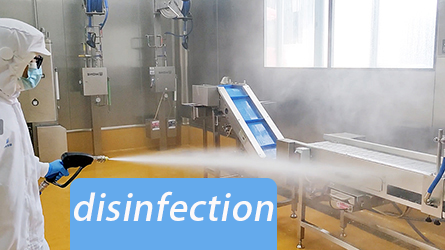Foam Cleaning System: Why OPC Systems Pay for Themselves
In industries ranging from food processing and agriculture to automotive manufacturing and healthcare, cleanliness is not just a matter of
aesthetics—it's a critical component of operational efficiency, safety, and regulatory compliance.
Traditional cleaning methods, however, often fall short in balancing cost, effectiveness, and sustainability. Enter the foam cleaning system,
a technologically advanced solution that integrates high-pressure rinsing, foaming, and disinfectant spraying into a single, streamlined proc-
ess. Beyond its immediate cleaning benefits, a well-designed foam cleaning system delivers measurable financial returns, making it a strat-
egic investment for businesses aiming to optimize their operations. Here let's explore how adopting an Open Plant Cleaning (OPC) foam
cleaning system generates a compelling return on investment (ROI) by reducing costs, enhancing productivity, and minimizing environmen-
tal impact.
The Hidden Costs of Traditional Cleaning Methods
Before diving into the ROI of a foam cleaning system, it's essential to understand the limitations of conventional approaches. Manual scrub-
bing, pressure washing, and chemical-intensive processes often require significant labor, time, and resources. For instance:
Labor Costs: Manual cleaning demands multiple workers to handle equipment, apply detergents, and rinse surfaces.Water and Chemical Waste: High-volume rinsing consumes thousands of gallons of water annually, while improper chemical dilution leads to overuse.
Downtime: Lengthy cleaning cycles disrupt production schedules, delaying output.
Equipment Wear: Aggressive scrubbing or high-pressure jets can damage sensitive machinery over time.
These inefficiencies erode profitability—a problem the foam cleaning system is engineered to solve.
How a Foam Cleaning System Works?
A modern foam cleaning system combines three core functions into one automated process:
High-Pressure Rinsing:
- Removes loose debris and prepares surfaces for deeper cleaning.
-
.png)
.png)
Foam Application:
- Thick, clingy foam penetrates stains and lifts contaminants without excessive water.
-
.png)
Disinfectant Spraying:
- After cleaning, the final step is to spray and disinfect.Ensures sanitization, critical for industries like healthcare and food processing.
-

What sets the foam cleaning system apart is its ability to adjust foam concentration based on the severity of stains. This precision reduces
chemical use while maintaining efficacy, a feature that directly translates to cost savings.
Calculating the ROI of a Foam Cleaning System
The financial benefits of a foam cleaning system manifest in four key areas:
1. Labor and Time Savings
Automation is a cornerstone of the foam cleaning system. By consolidating rinsing, foaming, and disinfecting into a single cycle, businesses
eliminate redundant tasks. For example:
A dairy plan t reduced cleaning labor by 50% after installing a foam cleaning system, as workers no longer needed to manually scrub equip-
ment.
These efficiencies free staff to focus on higher-value tasks, effectively lowering labor costs while boosting productivity.
2. Reduced Water and Chemical Consumption
The foam cleaning system's foaming mechanism maximizes the adhesion of cleaning agents to surfaces, allowing chemicals to work longerwithout dilution. Compared to traditional methods:
Water usage drops by up to 70%, as foam requires less rinsing.
Chemical consumption decreases by 30–50% due to precise concentration controls.
One automotive manufacturer reported saving $18,000 annually on water bills after switching to a foam cleaning system, alongside a 40%
reduction in detergent costs.
3. Minimized Downtime
In industries where downtime costs thousands per hour, the speed of a foam cleaning system is invaluable. Foam clings to vertical and ove-
rhead surfaces, cutting cleaning time by half in many cases. A poultry processing facility, for instance, reduced its nightly sanitation shift from
4 hours to 90 minutes using a foam cleaning system, reclaiming 150+ production hours monthly.
4. Extended Equipment Lifespan
High-pressure rinsing, when misapplied, can corrode machinery or degrade surfaces. The foam cleaning system mitigates this risk by using
optimized pressure settings and gentle yet effective foam. Longer-lasting equipment means fewer capital expenditures over time.
Environmental and Regulatory Benefits
Sustainability is no longer optional—it’s a competitive advantage. A foam cleaning system supports eco-friendly operations by:
Reducing Wastewater: Less water usage means lower treatment costs and compliance with discharge regulations.
Lowering Carbon Footprint: Efficient chemical use decreases the environmental impact of production and disposal.
Meeting Safety Standards: Consistent disinfecting helps industries adhere to FDA, OSHA, and EU regulations.
These factors not only avoid fines but also enhance brand reputation, opening doors to eco-conscious clients.
Case Study: ROI in Action
A beverage bottling plant faced mounting costs due to manual cleaning processes. After implementing a foam cleaning system, the results
were striking:
Labor Costs: Reduced from 12,000 to 6,000 monthly.Water Usage: Fell from 20,000 gallons/day to 6,000 gallons/day.
Production Downtime: Decreased by 60%, adding 200 hours of annual production.
Within 14 months, the system’s $85,000 upfront cost was fully offset by savings—a testament to the foam cleaning system’s rapid ROI.
Long-Term Value Beyond Savings
While the financial metrics are compelling, the foam cleaning system delivers intangible benefits that amplify ROI:
Employee Safety: Reduced exposure to harsh chemicals and strenuous labor.
Quality Control: Consistent cleanliness minimizes product contamination risks.
Scalability: Systems can be tailored to growing production needs.
Conclusion: A Smart Investment for Future-Ready Operations
The foam cleaning system is more than a cleaning tool—it’s a strategic asset that pays for itself through measurable savings and operatio-
nal improvements. By integrating high-pressure rinsing, intelligent foaming, and precise disinfectant application, OPC systems address the
inefficiencies plaguing traditional methods. For businesses prioritizing sustainability, productivity, and profitability, the foam cleaning system
offers a clear path to long-term success.
In an era where every dollar and minute counts, investing in a foam cleaning system isn’t just about staying clean; it's about staying ahead.


